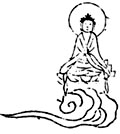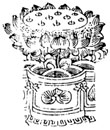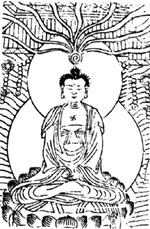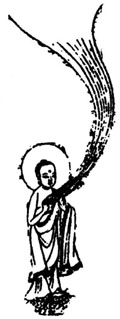|
PROLOGUE:
THE
FOURTH, DEPENDING ON THE SAMADHI. WHENEVER THERE IS MOVEMENT AND
STILLNESS, IT IS ONLY FOR CREATURES. HOW COULD IT BE TRUE OF A SAGE? HE
SETS OUT A TRACK FOR THOSE AFTER TO FOLLOW, MAKING CLEAR THAT WHEN ONE IS
ABOUT TO SPEAK, THERE MUST BE STILL EXAMINATION AND PRIOR CONTEMPLATION.
IN RECEIVING THE AID OF ALL BUDDHAS, IT IS UPON ARISING FROM SAMADHI THAT
ONE STARTS TO SPEAK. ONE'S WORDS ARE THEN CERTAIN TO BE SUITABLE AND TRUE.
SINCE ONE'S WORDS ARE SUITABLE AND TRUE, THE MINDS OF THOSE WHO RECEIVE
THEM NATURALLY HOLD TO THEM.
COMMENTARY:
THE
FOURTH, DEPENDING ON THE SAMADHI. The fourth is relying upon samadhi
concentration to speak the Dharma. The Dharma is not spoken using the mind
that is produced and destroyed, but using the mind in samadhi. Lack of
samadhi is production and extinction, but with samadhi, it is the mind,
which is not produced and not destroyed which is no thought. The Dharma is
spoken in samadhi, and so is said to depend upon it.
WHENEVER
THERE IS MOVEMENT AND STILLNESS, IT IS ONLY FOR CREATURES. When one says
there is movement and stillness, that is to speak from the point of view
of living beings, "creatures" just meaning all living beings.
HOW COULD IT BE TRUE OF A SAGE? From the point of view of, the Buddha,
there is no movement and no stillness. For the Buddha, movement does not
obstruct stillness or stillness cancel out movement. Movement and
stillness are a single suchness. For him, movement is stillness, and
stillness is movement. It's just that living beings for their part have
those kinds of distinctions. But how could that be true of a Sage? The
state of a Buddha is not like that. It has no movement or stillness:
The
Naga is always in samadhi, and is never not in samadhi.
HE
SETS OUT A TRACK FOR THOSE AFTER TO FOLLOW. He points out a path and rule
for the many disciples of the future, MAKING CLEAR THAT WHEN ONE IS ABOUT
TO SPEAK, a standard procedure should be observed. He himself acts as the
model and example for all living beings of what to do when about to speak,
of how THERE MUST BE STILL EXAMINATION AND PRIOR CONTEMPLATION. One has to
become still, enter samadhi, and look into the dispositions of the various
living beings who are to be taught, those "with potential." So
when you are going to lecture Sutras and speak the Dharma, the best thing
to do is to sit in meditation beforehand. Before I lecture Sutras, I, too,
like to have a period of time to meditate, so you shouldn't come ask me
about things in the hour or two preceding the Sutra lecture. I sit in
meditation and see who's having what false thoughts, as well as who will
believe what they need to hear and who won't believe, and for those who
will believe I speak what they will believe. I have this strange way of
lecturing Sutras. Sometimes I like to tell people what they won't believe,
for there's some meaning to it if they don't believe, while it's
meaningless if they do. Before you lecture you should sit in meditation
too, and take a look at the circumstances, to see if there's something
special about them. If there are special circumstances, speak something
special, and if there aren't any, then say ordinary things.
IN
RECEIVING THE AID OF ALL BUDDHAS. You contemplate the dispositions of
living beings, and request all the Buddhas of the ten directions to come
to your aid and support, and then IT IS UPON ARISING FROM SAMADHI THAT ONE
STARTS TO SPEAK. After you come out of samadhi, you talk. Don't come out
of samadhi and forget everything, saying, "Oh, just now I saw what
the potentials were. If I just think for a minute, it will come to
me." Then it's useless. If you know when you're in samadhi but forget
when you come out, it's useless. You need to remember the states you
contemplated in samadhi "and they must be true ones, for there are
false states, too. Demons can deliberately transform and send you rotten
states to trick you. Don't get fooled by the demons. You have to watch out
for that.
ONE'S WORDS
ARE THEN CERTAIN TO BE SUITABLE AND TRUE. If you come out of samadhi
without forgetting, what you say will be both accurate and appropriate.
You'll say just what you should. SINCE ONE'S WORDS ARE SUITABLE AND TRUE,
because the Dharma you speak is so exactly what the occasion requires, so
true, actual, and not false, therefore, THE MINDS OF THOSE WHO RECEIVE
THEM WILL NATURALLY HOLD TO THEM. The minds of your listeners will be very
solid and unshatterable concerning what you have said. They are sure to
believe you. Even if someone says to them, "Hey, you know, everything
said in the Great Means Expansive Buddha Flower Adornment Sutra is false,
you shouldn't believe it," they will reply, "Well, I like it all
the same."
PROLOGUE:
THEREFORE,
OF ALL THE ASSEMBLIES, IN MOST IT IS MADE CLEAR THAT ENTRY TO SAMADHI IS A
CONDITION FOR THE SPEAKING OF THE SUTRA.
COMMENTARY:
It
talked before about how the Buddha enters samadhi prior to speaking
Dharma, and how entering samadhi enables one to speak true and actual
Dharma, which makes those who listen and take it in hold to the Sutra with
great sincerity. THEREFORE, OF ALL THE ASSEMBLIES, the Nine Assemblies
of the Flower Adornment Sutra, IN MOST IT IS MADE CLEAR THAT ENTER TO
SAMADHI IS A CONDITION FOR THE SPEAKING OF THE SUTRA. In each assembly,
there is entry to samadhi, and afterwards the Sutra is spoken, so that is
part of the causes and conditions for the speaking of the Sutra. Among the
Nine Assemblies, there is no entry to samadhi in the Second Assembly, but
the Sutra is spoken upon arisal from samadhi in all the other eight
assemblies. That's why it says, "in most it is made clear." It
happens in eight cases out of nine, the one exception being the Second
Assembly.
In
the First Assembly, Universal Worthy Bodhisattva enters the Samadhi of the
Vairochana Treasury of Thus Come Ones' Body. In the Third Assembly, Dharma
Wisdom Bodhisattva enters the Samadhi of the Bodhisattva's Limitless Skill
in Means to speak the Dharma of limitless expedient means. In the Fourth
Assembly, Forest of Merit and Virtue Bodhisattva enters the Samadhi of the
Bodhisattva's Good Consideration, that of dhyana concentration. In the
Fifth Assembly, Vajra Banner Bodhisattva enters the Wisdom Light Samadhi.
In the Sixth Assembly, Vajra Treasury Bodhisattva enters the samadhi of
the Bodhisattva's Wisdom Light. In the Seventh Assembly, the Thus Come
One, Sakyamuni himself, enters and dwells in the Kshana-instant. In the
Eighth Assembly, Universal Worthy Bodhisattva enters the Buddha's Flower
Adornment Samadhi. In the Ninth Assembly, Shakyamuni Buddha himself enters
the Lion-Sprint (Simhavijrimbhita) Samadhi.
There
is no entry to samadhi in the Second Assembly, but it might have been lost
when the Sutra was translated from Sanskrit to Chinese. As it is, the text
says that in most it is clear that entry to samadhi forms part of the
causes and conditions for speaking the Sutra.
PROLOGUE:
THE
ONE WHICH HAS NO ENTRY TO SAMADHI WILL BE DISCUSSED WHEN THE TEXT IS
REACHED. THE REST WHICH DO HAVE ENTRY TO SAMADHI ALL EXHAUST THE DHARMA'S
SOURCE, THEIR KARMIC FUNCTIONINGS BEING DIFFICULT TO CONCEIVE.
COMMENTARY:
THE
ONE WHICH HAS NO ENTRY TO "SAMADHI WILL BE DISCUSSED WHEN THE TEXT IS
REACHED. When we come to the Second Assembly in the text of the Sutra,
this will be explained. THE REST WHICH DO HAVE ENTRY TO SAMADHI, the other
eight Assemblies, ALL EXHAUST THE DHARMA’S SOURCE. They exhaust the
fountainhead of Dharma, THEIR KARMIC FUNCTIONINGS BEING DIFFICULT TO
CONCEIVE. They all receive the aid and support of all Buddhas in the three
karmic activities, and the functionings of those karmas are inconceivable.
PROLOGUE:
THE
FIFTH, DEPENDING ON THE MANIFESTATION OF MARKS. THAT IS, THE DHARMA NATURE
IS STILL AND SILENT AND, ALTHOUGH IT HAS NO MARKS, THE CHARACTERISTIC OF
MARKLESSNESS DOES NOT OBSTRUCT PROLIFIC FLOURISHING.
COMMENTARY:
THE FIFTH
is PENDING ON THE MANIFESTATION OF MARKS to speak the Dharma. What does
that mean? THAT IS to say, THE DHARMA NATURE IS STILL AND SILENT. The
Dharma Nature is empty, AND, ALTHOUGH IT HAS NO MARKS, even so THE
CHARACTERISTIC OF MARKLESSNESS DOES NOT OBSTRUCT PROLIFIC FLOURISHING. It
Still does not interfere with the existence of marks, the prolific
flourishing of lots and lots of mark's arising.
PROLOGUE:
IN
THE ARISAL OF THE TEACHING THERE ARE MANY EVENTS AND THE MARKS ARE NOT A
SINGLE TYPE. THERE MAY BE EMISSION OF LIGHT, shaking OF KSHETRAS, OR
FLOWERS THAT RAIN DOWN AND CLOUDS OF INCENSE, ALL OF WHICH CONTRIBUTE TO
THE ARISAL.
COMMENTARY:
In
as much as the characteristic of marklessness does not obstruct prolific
flourishing, IN THE ARISAL OF THE TEACHING THERE ARE MANY EVENTS. When a
teaching arises, there are a considerable number of things that happen.
AND so THE MARKS ARE NOT OF A SINGLE TYPE. There's no fixed canon for the
kinds of signs that appear. It's not to say that the heavens have to rain
precious flowers, or that there must be an emission of light. For example,
at the speaking of the Dharma Flower Sutra, the Buddha emitted light, made
the earth quake, and caused a rain of heavenly mandarava flowers as
portents. When the Mahaparinirvana Sutra was spoken, on the other hand, the
marks he used were sounds and light, which pervaded everywhere and made
proclamation to the Great Assembly. When he spoke the Prajna Sutra, the
sign he used was the scattering of golden blossoms. Now, at the speaking
of the Great Means Expansive Buddha Flower Adornment Sutra, the worlds of
the Flower Treasury experience the six kinds of quakes, and the heavens
rain down precious flowers which descend in colorful profusion, in
addition to there being clouds of incense, rains of clouds of flowers,
rains of clouds of garlands, rains of necklaces, and a great many more
kinds of clouds. It's not fixed what marks will appear, so it says, THERE
MAY BE EMISSION OF LIGHT, QUAKING OF KSHETRAS, which means earthquakes, OR
FLOWERS THAT RAIN DOWN AND CLOUDS OF INCENSE, Heavenly mandarava flowers
may descend as rain, or there may be rain of various kinds of incense
clouds, ALL OF WHICH CONTRIBUTE TO THE ARISAL. They are all causes and
conditions for the arisal of the teaching.
|





